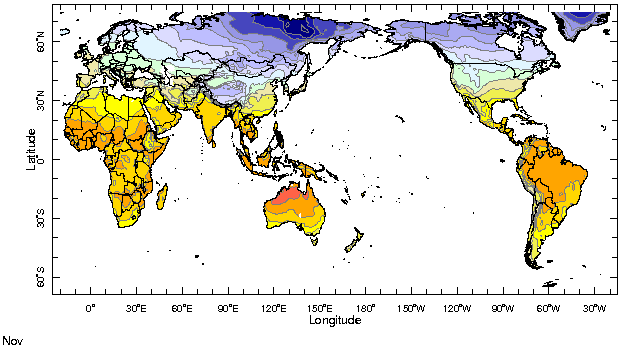|
IRI Climate Digest
December 2002
November Global Climate Summary
Climatological Background
During November, the Northern Hemisphere mid-latitude storm tracks increase in strength, while monsoon systems in South Africa, Australia, and South America expand southward, following the maximum solar heating. Tropical storm activity winds down in the North Atlantic, the North Pacific, and northern Indian Oceans.
Monthly Mean Temperature (1961-1990), data from the Climate Research
Unit, University of East Anglia


Monthly Mean Precipitation (1961-1990), data from the Climate Research
Unit, University of East Anglia


Temperatures
Highlights
In November, warmer-than-normal temperatures intensified in Alaska and eastern Russia, and spread into western Canada. Above-normal temperatures also continued in much of central Asia and the Middle East, and developed in Europe south of about 55 degrees north. Warm anomalies continued in Australia, particularly in Queensland and New South Wales. Most of Africa north of the equator was warm as well. Colder-than-normal conditions persisted in Scandinavia for the second month in a row. Cold anomalies were also found in northeastern China, Korea, and the Japanese Islands, and in much of eastern North America.
Temperature Difference from the 1961-1990 mean, with data
from NCEP Climate Prediction Center, CAMS.


Precipitation
Highlights
Precipitation patterns in several regions continued to be consistent with those typically seen during El Niņo events. These include unusually dry conditions in northern South America, the Caribbean, the northwest United States, Indonesia, eastern Australia and southern Africa. The unusally wet conditions during November across the southern US, southeastern Brazil, northeast Argentina and much of Uruguay are also typical during El Niņos.
Precipitation Difference from 1961-1990 mean, with data
from NCEP Climate Prediction Center, CAMS-OPI.


Oceanic Conditions
Tropical Pacific: El Niņo conditions continued during November and extended further east towards the South American coast. The sea surface temperature (SST) anomalies in the central Pacific maintained their magnitude of approximately 2.5-3°C while those in the eastern Pacific increased to 2-2.5°C. It is highly likely that these conditions will continue through March 2003 before any significant weakening occurs. See the latest IRI ENSO Update for a detailed summary and outlook.
Tropical Atlantic: Near normal conditions continued to dominate the tropical Atlantic.
Indian Ocean: The warm anomalies in the central and western regions of the Indian Ocean continued, but the areal coverage and magnitude of the anomalies decreased slightly from those observed last month.
Mid latitudes: The warm anomalies in the Gulf of Alaska maintained their magnitude of 2.5-3°C and shifted northeast towards the North American coast. The warm anomalies off the southeast coast of South America also continued and were accompanied by the development of cold anomalies across the southern Atlantic.
Monthly Sea Surface Temperature Difference from the 1950-1979 mean,
with data from the Environmental Modeling Center, NCEP/NOAA.


Contents |
Special |
Impacts |
Climate |
Forecast
|

